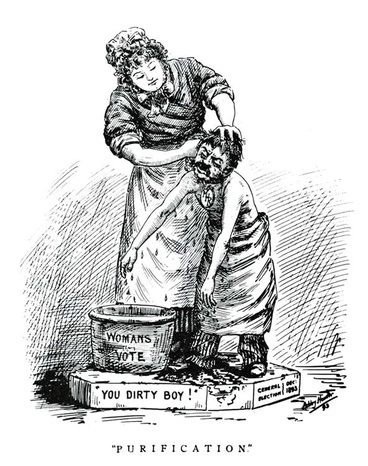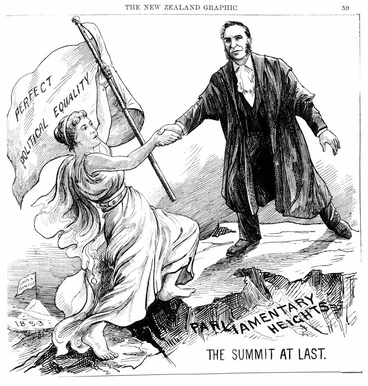1893 Anti-suffrage cartoon
A DigitalNZ Story by National Library Services to Schools
This 1893 anti-suffrage cartoon mocks reversed male and female roles while warning what could happen if females got the vote and turned into a ‘man-tamers.’
These resources and text relate to an anti-suffrage cartoon and the impact of the campaign for female emancipation. They have been sourced and collated from DigitalNZ and other websites.
What, dinner not ready yet! What have you been doing?, a cartoon by William Blomfield
Alexander Turnbull Library
Background
The world turned upside down? A typical anti-suffrage cartoon warns that tampering with men’s and women’s ‘natural’ gender roles could cause the breakdown of society – or at least screaming babies, burnt dinners and cats in the milk jug.
Source: 'Cartoon against women's suffrage', URL: https://nzhistory.govt.nz/media/photo/anti-womens-suffrage-cartoon, (Ministry for Culture and Heritage), updated 23-Dec-2013
A feature of the suffrage campaign was the propaganda of those opposed to women having the right to vote which was often centred on some belief that the natural order of society would somehow be turned on its head. For those in favour of women voting a belief was that women would have a civilising impact on politics and contribute to a raising of the standards of behaviour of male politicians.
THE HOUSE KEEPING HUSBAND. (Poverty Bay Herald, 04 July 1914)
National Library of New Zealand
HUSBAND AS HOUSEWIFE. (Mataura Ensign 25-2-1913)
National Library of New Zealand
Mrs N? Mackie in the kitchen making a pot of tea, wife of Jockey Mr C Mackie
Alexander Turnbull Library
Context
Today, the idea that women could not or should not vote is completely foreign to many New Zealanders. 125 Years on since New Zealand women achieved the vote we have a woman Prime Minister who like many other women is combining work with motherhood. The 52nd Parliament of New Zealand elected in 2017 has 46 women MPs, the highest level of representation for women in our history. Women make up 38.4 percent of the total 120 MPs in this Parliament, a boost of 7 percent on the previous Parliament elected in 2014. Women have held each of the country’s key constitutional positions: prime minister, governor-general, speaker of the House of Representatives, attorney-general and chief justice.
From the mid-19th century, women in a number of countries began campaigning for the right to vote. While the campaign in Britain saw more confrontational tactics employed, suffragists (suffragettes) In New Zealand used largely peaceful and dignified methods to push for change. Public meetings and petitions, in particular, were employed but despite such peaceful approaches many of their opponents viewed their actions as abhorrent and indecent. They argued that these women were making fools of themselves, their husbands and their families in their demands to be treated as equals with men.
Those opposed to women’s suffrage did not hesitate to portray suffragettes as embittered old maids, ‘brutal scolds’, or cigar-smoking transvestites. Their male supporters were often described as weak or the ‘hen-pecked’ victims of over-bearing wives.
Fertile questions
What else changed when women won the right to vote?
How do authors use images and words to affect an audience?
Does it matter who cooks? Why?
He mana tō te tangata ahakoa ko wai. Pēhea ōu whakaaro?
What is your question?
Kitchen interior
Alexander Turnbull Library
Quick facts
- Bloomers (like those shown in the featured cartoon) were a type of divided dress worn as a lighter and more comfortable alternative to the long heavy 19th century dresses. They took their name from Amelia Bloomer an early feminist and women’s rights campaigner.
- In Britain, more than 1,000 suffragettes were imprisoned leading up to the outbreak of the First World War. They were imprisoned for such things as demonstrating, resisting arrest and destroying public and private property. Some even planted bombs and burnt down buildings in a militant campaign seeking the right to vote.
- The word suffrage comes from the Latin suffragium meaning ‘vote or right of voting.’ It simply means to the right to vote in political elections.
- A suffragette’s march through London in 1908 saw 300,000 protesters with 700 banners.
- One of the 100-year suffrage celebrations in New Zealand in 1993 was the planting of white camellia shrubs across New Zealand including in the grounds of Parliament. The white camellia flower was a major symbol of the New Zealand’s women's suffrage movement.
- In Wellington in September 2014 ‘Cross now’ pedestrian green man lights were replaced with a picture of Kate Sheppard on eight Wellington intersections around Parliament.
Purification suffrage cartoon
Manatū Taonga, the Ministry for Culture and Heritage
Scene outside a house, including a woman at a sewing machine, a child, and geese, Buller region
Alexander Turnbull Library
Other resources
An experiment — gender equality pay gap experiment.
Anti-Suffragette postcards posters & cartoons — a collection of cartoons and posters mocking the suffragette campaigns for votes.
Dads happy to stay home— the rise of the house husband.
Girl toys vs boy toys— the experiment.
Saudi Arabia's women vote in election for first time— women in Saudi Arabia cast their votes for the first time.
Sign the petition — this story shows how the 1893 suffrage bill was represented in satirical newspaper cartoons of the day.
Stay-a-home-dad — people don’t get it.
Suffragist or suffragette? — what is the difference?
The fight to vote by Susan Paris School Journal. L4 May : 2017. Year 7.
Woman suffrage postcards — in 1910, the National American Woman Suffrage Association put their best arguments on postcards.
The summit at last, suffrage cartoon
Manatū Taonga, the Ministry for Culture and Heritage
This story was compiled and curated by Te Puna Mātauranga o Aotearoa | National Library of New Zealand, Services to Schools staff, in 2019.

